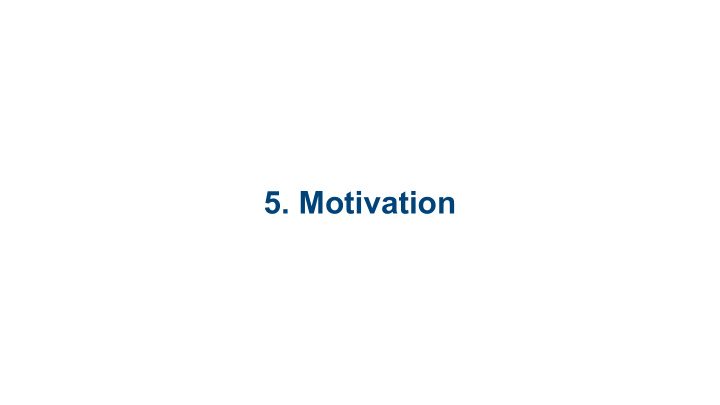



5. Motivation
Motivation: Big Questions • Where does motivation come from? • Can motivation be created or increased? • What motivates school- age children?
5.1 Behavioral Theory 5.2 Human Needs Theory 5.3 Attribution Theory 5.4 Social Learning and Expectancy Theory 5.5 Achievement Motivation
5.6 Intrinsic and Extrinsic Motivation 5.7 Reinforcement Contingencies 5.8 Learned Helplessness 5.9 The Effects of Anxiety on School Performance 5.10 Summary
5.1 Behavioral Theory
Behaviorism: Motivation through reward • Emphasis on rewarder to shape motivation • What/when/how often to reward? • Receiver must expect and value reward • Does this explain all motivation?
5.2 Human Needs Theory
Maslow’s hierarchy of inner needs 1 • To fill deficiencies • Survival • Safety • Belonging • Self-esteem
• For personal growth • Achievement • Aesthetics • Self-actualization
Hierarchy of needs 2 • Teacher obligated to provide for deficiency needs • Positive relation with students • Guarantee safety • Build community • Build self-esteem
Hierarchy of needs 3 • When school/classroom meets deficiency needs, students motivated to learn for personal growth needs • Achievement (doing personal best) • Aesthetics (appreciation and artistry) • Growing/showing integrity (citizenship, responsibility)
5.3 Attribution Theory
Attribution: Motivation by weight of success factors • Internal locus of control • Ability • Effort and persistence • External locus of control • Difficulty of task • Luck • Motivation related to which locus person emphasizes
Internal vs external • Motivation related to which locus person emphasizes • Internal locus of control • Confidence about trying and achieving • Self-efficacy about future challenges • External locus of control • Low confidence, low self- efficacy
Building the internal Teachers obligated to boost internal locus of control • Individualized work and expectations • Activities planned with high probability of success • Quick and realistic feedback • Teacher and/or peer support • Celebrate success
5.4 Social Learning and Expectancy Theory
Motivation by viewing and reviewing success 1 • Learn from vicarious experiences: viewing effectiveness and success • Students view examples of effective thought, action • Students review what was involved in success
Motivation by viewing and reviewing success 2 Teachers obligated to model and encourage modeling • Teach good academic skills • Build community for social persuasion/support • Emotional support/feedback by teacher and peers ➔ Builds self-efficacy
5.5 Achievement Motivation
McClelland: Striving to achieve • 1 of 3 motivations: power, affiliation, achievement • From genetics and/or early experiences? • From values and beliefs based on experience? • Influenced by culture and gender?
Boosting achievement motivation • Teachers usually highest in power (influence) – not best models for achievement! • Fostering achievement motivation • Encouragement • Feedback • Celebration • Reward?
5.6 Intrinsic and Extrinsic Motivation
Intrinsic vs extrinsic motivation • Intrinsic (internal) = self- reward, effort, persistence • Extrinsic (external) = dependent on reward • Can’t give intrinsic motivators, but you can encourage/discourage ➔ Can extrinsic kill intrinsic motivation? (Answer: yes)
5.7 Reinforcement Contingencies
Extrinsic to intrinsic • Move toward self-regulation (manage own behavior, use effective work habits) • Lessening rewards while maintaining expectations • Encouragement/appreciation instead of rewards • Trust-based privileges rather than incentives, rewards
Extrinsic to intrinsic • Emphasize relevance of each learning experience • Multi-modal teaching • Teach/encourage goal-setting • Clear expectations • Clear, quick feedback • Rewards with learning value (centers, library, research)
5.8 Learned Helplessness
Helpless = unmotivated • Assume events and outcomes not controllable • External locus of control and low self-efficacy • From failure and negativity (conditioned response?) • Reduces motivation/ morale
Countering helplessness • Don’t accept or enable • Positive, encouraging • Realistic assessment of abilities • Realistic feedback on progress • Counseling? Assess for learning disabilities?
5.9 The Effects of Anxiety on School Performance
Dealing with anxiety • Preschoolers to teens! • Feeling tense, unease, worry, or overwhelmed • With or without knowing cause • Undermines motivation, morale, achievement, social interaction, even physiology • Check around testing time!
Countering anxiety • Take it seriously • Adjust environment: • Consistency • Low stress • Take breaks • Set realistic goals • Inject humor (even at test time?)
5.10 Summary
Motivate: Push or pull? • Motivation can be either inner or outer • Inner ➔ lasting results and self-regulation • Enhanced by reward, encouragement, feedback, skills training, goal-setting • Factors: locus of control, past successes, level of self-efficacy, guidance
Recommend
More recommend